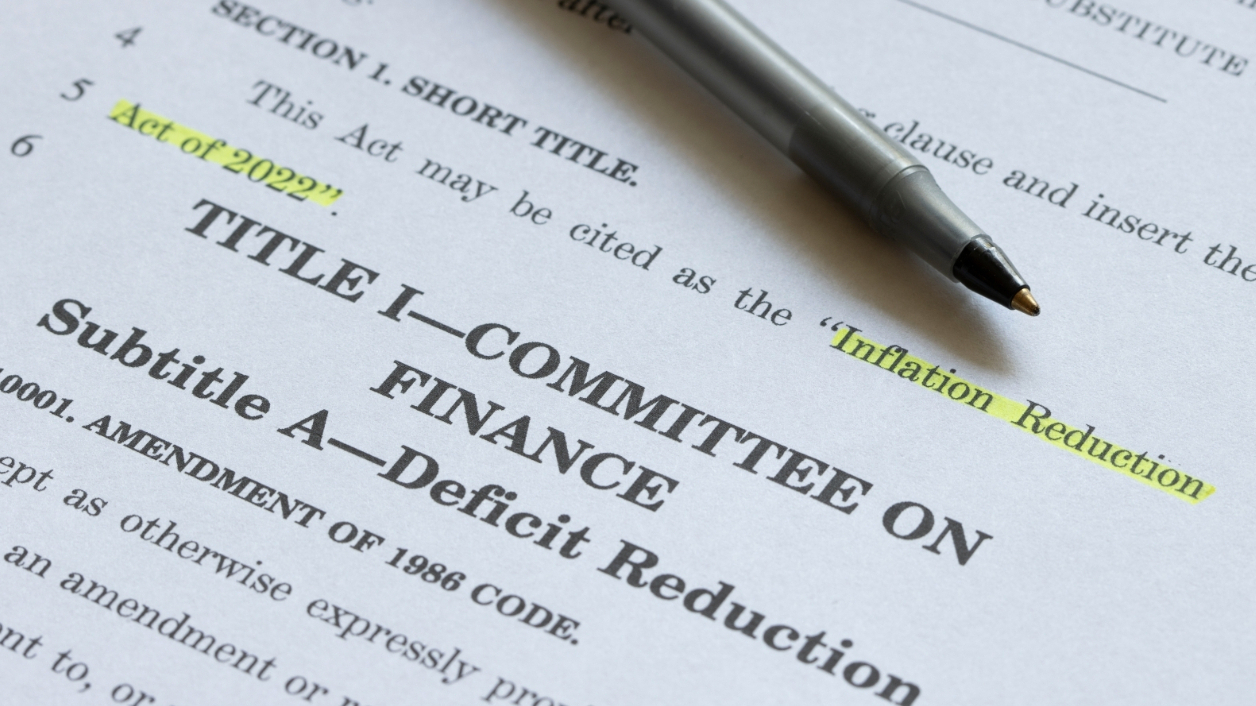
How new laws are ramping up the push for renewables investment
The Inflation Reduction Act in the US has already seen increased capital diverted to American renewables projects. Can the rest of the world catch up?
In August 2022, US President Joe Biden signed the Inflation Reduction Act (IRA) into law. Representing possibly the most significant single piece of climate legislation in the nation’s history, within the bill was $369 billion set aside over ten years to support renewable energy, pollution reduction, and decarbonisation activities.
The IRA also included tax breaks for electric vehicles, heat pumps, batteries, nuclear power, clean hydrogen generation, wind and solar energy. Even though the tax credits are due to expire in 2032, the bill also contains language allowing for their extension for decades longer.
Travis Miller, energy and utilities strategist for financial services company Morningstar, explains the benefits the IRA holds for the renewables sector: “There are two impacts. For independent developers, the certainty around the tax benefits should help financing for these projects. The second is that, with the extent utilities are investing in wind and solar projects directly, there should be a lower overall cost for customers.”
In the US, Miller points to the previous Infrastructure Investment and Jobs Act of 2021 as being a benefit to renewables investment, with the combination of both bills being a big advantage to putting capital towards areas such as hydrogen.
Last October, the Biden administration also announced plans to invest more than $7 billion to develop hydrogen production hubs, with a goal of meeting 10 million tonnes of demand for the clean energy source by 2030.
Of how the IRA can impact renewables investment, Alex Harrison, head of energy and renewables at law firm Akin, is upbeat: “[The IRA] is absolutely transformative to the global race for net zero, representing the largest single stimulus package of its kind,” he says.
“When you combine it with previous legislation, it is a massive reason to think about delivering your net zero projects in the US rather than elsewhere in the world. We're already seeing clients looking very seriously at doing so.”
Harrison is also in agreement that if the European Union is to hold on to its mantle as the foremost continent for renewables development, it needs further regulatory impetus of its own.
[the IRA] is transformative in the race for net zero.

What say EU?
Widely reported as a direct response to the IRA, in February this year the European Union proposed a Green Deal Industrial Plan.
As part of this regulation, the commission has proposed a Net-Zero Industry Act, which closed its public consultation on 23 May. The act looks to identify goals for net-zero industrial capacity and provide a regulatory framework suited for its quick deployment, promoting European strategic projects, and developing standards to support the scale-up of technologies across the Single Market.
Yet the plan has already seen its share of detractors. Financial services firm Allianz has claimed the legislation could “open the Pandora’s box” of a subsidy race to the bottom between the EU and the US, and German think tank Heinrich-Böll-Stiftung argued that the plan’s details of adjusting rules for state aid will primarily benefit the wealthier EU economies.
However, for Sebastian Peck, partner at venture capital firm Kompas, issues within renewables investment in the EU would not necessarily be solved by new legislation: “There isn’t a funding problem in the EU, there is a policy execution problem.
“Politicians and civil administrations, whether at the EU level or national level, need to become more efficient in deploying that funding and making it accessible rather than hidden in an obscure corner.”
In terms of financing for renewables projects in the EU there is the €250 billion Recovery and Resilience Fund for the green transition plus around €270 billion available through REPowerEU. This amount exceeds that which has been earmarked in the IRA by a significant margin, even before including funds available through the EU budget and other programmes such as Horizon Europe, Invest EU or the Innovation Fund.
Comparing the US IRA with the current state of play in Europe, Jon Wallace, fund manager at Jupiter Green Investment Trust, says: “We’re already seeing the IRA have a significant impact on the renewables space, with businesses starting to report orders that are linked to the tax incentives, as well as signalling new investment in production capacity in the US to take full advantage.
“Whilst Europe has also set aggressive targets for renewables, the EU Commission is taking steps to address the bottleneck in its planning procedures, with over 80GW of wind projects stuck in the permitting process at the end of 2022.”
Marija Simpraga, infrastructure strategist in asset management company LGIM's real assets division, points out that there has been very strong continued growth in traditional renewables deployment such as wind and solar in Europe over the past year, collectively overtaking gas as an energy source in 2022 for the first time.
However, Simpraga also sees the comparative advantages to the Inflation Reduction Act: “There’s been a lot of chatter about how the IRA is going to just hoover up all the assets and all the development activity away from Europe.
“The situation is probably a bit more nuanced than that. There are subsidies available in both markets, but the difference is the ease with which you can access them. That's probably where the IRA has an advantage with the tax credit system.”
We’re already seeing the IRA have a significant impact on the renewables space, with businesses starting to report orders that are linked to the tax incentives.
Wider world
While the US and the EU represent two political heavyweights battling over the future of renewables investment, they are by no means alone in the fight for asset allocation to this sector. Another contender is a nation that was until recently a European Union member; the United Kingdom.
Harrison at Akin says: “The UK is positioned post Brexit in this race to be between the US and the EU.
“However, overall my thought is that the EU and the USA are really going to drive this forward and there's a risk that the UK gets left behind. We'll have to see where the UK ends up with the EU and the US both running very hard, trying to outshine each other in order to attract the investment that's available.”
In March this year, the UK government's revised net zero proposals and green finance policies received a lukewarm response among investors, managers and analysts.
Harrison also noted interest in renewables projects from clients in East Asia, specifically South Korea, Thailand, and Vietnam. At Kompas, Peck also observed increased desire from the firm’s Tel-Aviv office for renewables investments, driven in part by Israel’s need to reduce dependence on oil imports.
Of international opportunities, Alex Brierley, co-head of Octopus Energy Generation’s fund management team, says: “Globally there’s a massive opportunity to improve energy security through cheap, clean renewables. We’re seeing significant demand from countries across the Asia-Pacific - and to meet this we’ve recently committed to invest £1.2 billion in renewables in this region.
“The opportunity to shift the global energy system to 100% renewables is a massive one - and there’s plenty of capital to go around. Institutional investors are playing an absolutely integral role as catalysts turbocharging this shift to net zero.”
Paris Agreement
Underpinning net zero drives worldwide is the Paris Agreement, with nations agreeing to limit global warming to 1.5°C at the 2016 COP21 climate event. While nations were signatories, much of the corporate and investment world has also since made the same commitment.
Of regulation in the era following the Paris Agreement, Robert Wall, head of sustainable private infrastructure at Lazard Asset Management, says: “Policy makers are shifting towards initiatives and plans that promote sustainable technologies to address the combined impact of three major trends; the decarbonisation of energy to reduce the impact of climate change, securing energy supply independent of geopolitics, and supporting the industrial competitiveness of countries.”
At COP26, countries representing more than 80% of CO2 emissions pledged to reach net zero. If this target is to be reached by the 2050 goal, the McKinsey Global Institute estimates spending on physical assets would reach $275 trillion. With this amount of money required to be spent, regulation encouraging investment such as the Inflation Reduction Act and the Green Deal Industrial Plan may just be the tip of the iceberg.




